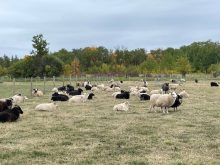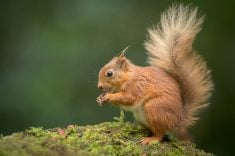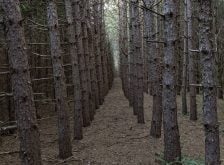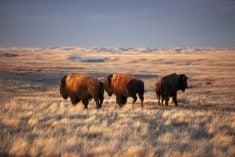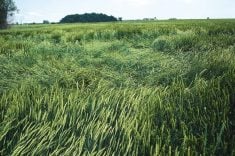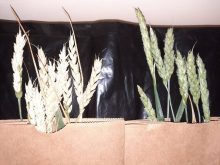When I lived in rural Alberta in the 1970s, I knew more than a few farmers and acreage owners who supplemented their incomes, sometimes substantially, with coyote pelts. The price for good pelts at that time was up to $100 or more.
Today, with the advent of synthetic furs and an anti-wild-animal-product public atmosphere, coyote fur rarely fetches more than $50 per quality pelt and often pelt sales are slow or nonexistent. Despite this fact, in recent years in Saskatchewan, for example, up to 3,000 trapping licences are issued annually, and pelt sales numbering close to 15,000 returned some $840,000 to the assorted coyote trappers realizing $56 per pelt. A $50 pelt in 2000, counting inflation, would probably be double or triple to today’s value. The licence situations in Alberta and Manitoba are similar to those in Saskatchewan.
Read Also

Gentle treatments for pain in the neck
Heading toward year-end, people unknowingly tense up against the cold and busyness, causing neck pain that can often be treated with appropriate support and gentle mobility, athletic therapist Kathlyn Hossack says.
Anyway, what is a coyote? In Eastern Canada, a coyote is called a brush wolf or little wolf, and in the West, a coyote or Prairie wolf. Coyotes (Canis latrans) live 10 to 14 years, can run at 40 miles per hour and are very readily interbreedable with both wolves (coywolves) and domestic dogs (coydogs).
I know of individuals in Canada who have coyotes as seemingly good pets. I even know one family in Ontario who kept a stray puppy only finding out it was a coyote when they took the puppy to a veterinarian to get fixed. Coyote comes from the Mexican Aztec word coyotl. Why are coyotes more common in urban areas? Do I have the answer? Because they do not get shot.
The good and the bad
In past and recent years, there seems to be perpetual debate on the Canadian Prairies and south of the border about killing off coyotes. In Manitoba, for example, coyotes are responsible for 62 per cent of livestock losses and bears and wolves for the remainder. Combined, these three carnivores prey on some 2,000 commercial animals annually in Manitoba. Most losses are lambs and calves.
Manitoba has around 420,000 beef cattle and, perhaps, 40,000 dairy types along with some 90,000 sheep. Excluding other specialist breeds, such as llamas and cervids, we have more than half a million pasturing animals.
In the year 2000, pasture animal losses came in at less than a half per cent of the total livestock population. Even down to almost a quarter per cent of the animal total or so taken by coyotes. In many instances, near urban areas, domestic dogs may kill or mutilate livestock but coyotes are blamed.
Now for any farmer losing livestock to predation, the loss is very real and personal. Farmers who run into this problem have recourse to a “Wildlife Damage Compensation Program for Livestock Predation.” Up to 90 per cent of the animal loss is paid for by the Government of Canada and the Province of Manitoba. This insurance includes cattle, horses, sheep, hogs, goats, elk, deer, bison, llamas, donkeys, ostriches and even penned wild boars. Similar programs on predation by wildlife exist in Saskatchewan, Alberta and British Columbia.
The big picture
The coyote is guilty of livestock predation but how does this cost of farm animal loss compare with farm crop value gain as a consequence. What does the coyote feed on in Prairie Canada — or countrywide for that matter?
Coyotes feed on rats, mice, voles, pocket gophers, ground squirrels, rabbits, geese, ducks, groundhogs, deer, wild boar, raccoons and other crop-damaging fauna, including grasshoppers and cutworms. Coyotes will also eat apples, berries, carrots and other vegetables.
Now, if we add up the coyote predation in Manitoba at 1,200 farm livestock and allow $500 per animal (usually lambs or calves), we come up with around $600,000 in animal losses.
Coyote prey animals
Can you imagine in the three Prairie provinces how much crop damage could be carried out by the deer family, pocket gophers, ground squirrels, voles, mice, rats, rabbits, wild boar and even geese? Have you read the reports of massive plagues of mice in Australia last year? Mice by the billions destroyed huge areas of Australian cropland. Have you looked at sheep and cattle pastures in the United Kingdom and noticed there are more rabbits feeding on the grass than livestock, not counting the holes they dig and the stones brought to the cropland surface?
I would personally be very happy to see any of our Prairie universities run programs and estimate the countless millions of dollars that are saved on farm crops from oats to peas by coyote predation on the offending wildlife. I could hypothesize that for every dollar in coyote livestock loss we gain about a hundredfold in crop and animal pasture yield. I have seen as many as a hundred or more mule deer feeding on a good hayland crop and the farm owner says nothing. On the other hand, if a dozen or so cattle stray onto this hayland all kinds of concerns occur, from compensation to litigation.
Recently, the alarm over our exploding wild boar population is front and centre in the Prairie press. All kinds of methodologies and control situations have been proposed — no one has mentioned possible coyote predation on the piglets. When we allowed farmers to raise wild boar in the 1980s in Alberta, we were told they would not survive outdoors in the Prairie winter. Wild boars are in fact common in the coldest parts of Siberia. Some wild boars are so woolly that they almost look like sheep.
In Italy, in the wildlife areas, wild boar populations are kept stable by wolves. It was calculated the average wolf kills up to 50 piglets or young pigs in a year. Couldn’t coyotes be responsible for piglet kills? Piglets are very small, easy to catch and coyotes could certainly outrun a wild boar mother.
Please do not get me wrong, I am not putting coyotes on a pedestal. If you are a trapper, a farmer making pocket money, or you have problems with coyotes around your livestock, then sell the fur or eliminate the problem coyotes in and around your livestock operation.
I hope that you will give this script some thought on this “Prairie wolf” and realize the good and forget about those needless shootouts that extirpate these farm crop guardians every winter in Prairie Canada.
I live in the country, west of Edmonton. My five acres is fully fenced from coyote and deer. In the woodlots around my acreage, I have lots of deer and moose along with at least three coyote packs. I have kept sheep and chickens for more than 20 years and I have never had any coyote problems. I lost one rooster to a fox and many bantam chickens to ravens.
Eight years ago, in February, a stag did jump my eight-foot fence ostensibly followed by a cougar, which I found out later when the cougar left just deer skin and bones. My sheep were open penned only 100 feet from the cougar feeding site. Perhaps my two border collies did dissuade the cougar from attacking my sheep or, perhaps, it had an aversion to mutton. Perhaps cougars could be persuaded to prey on wild boar in addition to coyotes and wolves. Predators such as coyotes, wolves and cougars bring out the worst in us and we, as farmers, forget their roles as excellent biocontrol pest agents.




